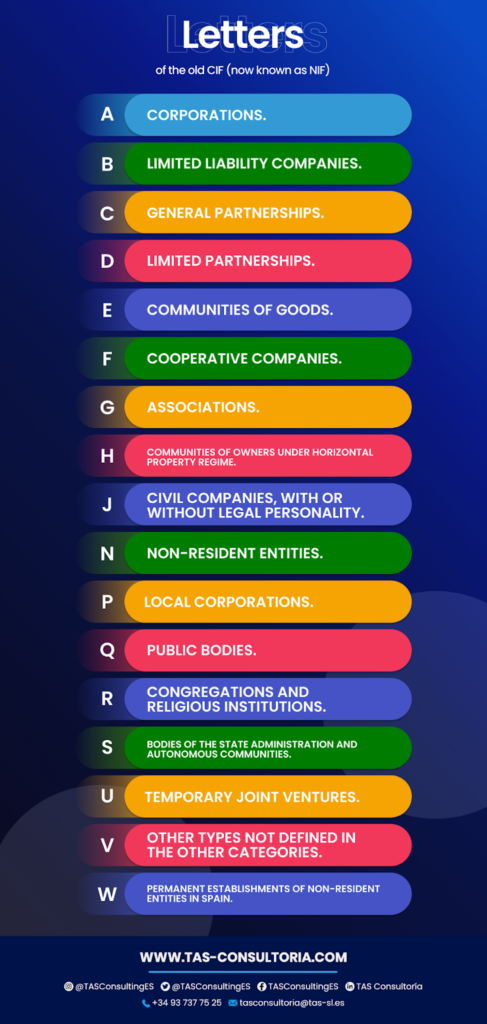
Get ready for a revelation! The CIF, or Tax Identification Code, has been out of use for longer than you might think. This tax identifier that used to be used by companies and foundations was transformed into the NIF (Tax Identification Number) in 2008. We explain the differences and how they affect your situation, read on and stay up to date!
What is the purpose of the NIF in Spain?
The NIF, known as the Tax Identification Number, is an important code if you are a taxpayer. It serves to identify individuals, companies and other unincorporated entities.
Originally, until 2008, this code was assigned exclusively to individuals involved in commercial activities. However, as of that year, the NIF was also extended to include legal entities. Based on the legal modification established in Royal Decree 1065/2007, of July 27.
The NIF in the Spanish context consists of nine characters, which consist of a letter that denotes the legal nature. Whether it is a Spanish entity, a foreign entity or a permanent establishment of a non-resident entity in Spain. Always followed by a random number composed of seven digits and a control character.
You may also be interested in: What is an intra-community VAT number?
What is the impact of the change from CIF to NIF?
Despite this, we still find the CIF on some invoices, websites or when a customer provides us with their details. It is true that it is still used colloquially to refer to the identification of companies.
But, from a legal point of view, it is the VAT number that you must include on your invoices. Either when recording customer or supplier information. Likewise, if you are a company, you must use the NIF when providing your fiscal data.
What are the letters of the old CIF that now corresponds to the NIF?
If we look at the NIF of a company, we will notice that it is different from that of an individual. This is due to a change in the regulations that altered the way these numbers are generated.
In the case of the NIF for legal entities, a letter always precedes it. This provides information about the type of legal structure and the nationality of the entity.
Below is a list of the initial letters of the CIF and the corresponding type of entity:

Based on the initial letter, the NIF is composed of 8 digits, as mentioned above:
- The first two identify the province.
- The following 5 are correlative digits according to the provincial registry.
- The last digit, which can be a letter or a number, is used to control and validate the format of the TIN.
You may also be interested in: What is the NIF in Spain and how to obtain it?
What are the differences between DNI and NIF?
The DNI, known as Documento Nacional de Identidad (National Identity Card), is a personal and non-transferable document. Its purpose is to confirm the identity and Spanish nationality of its holder.
This document is issued by the General Directorate of the Police, which is part of the Ministry of the Interior. In that sense, it is used in a wide range of daily transactions, as well as in several formalities.
Its uses include serving as a passport for travel to countries that accept the DNI. It also works as an electronic signature tool for documents, guaranteeing the authenticity of signatures, and other applications.
In contrast, the NIF is used specifically in matters related to taxes and customs. In other words, both individuals and legal entities involved in tax operations are required to have a tax identification number (NIF).
This number must be included in the self-assessments, declarations and communications filed with the Administration.
In the case of Spanish citizens who, although they are not required to have a DNI, the administration will assign them a NIF. Clearly, if they request it.
Such is the case of Spaniards not residing in Spain or minors under 14 years of age residing in the country. For non-residents, the NIF will begin with the letter “L”, while for minors, it will begin with the letter “K”.
Now, what are the distinctions between NIF and NIE?
In general terms, there are no significant differences between the NIF, which is used by Spanish citizens with DNI, and the NIE. The latter represents the foreigner’s identity number, used by foreign nationals. Both function as identity documents.
A similar case occurs as mentioned above. When a foreign person lacks a NIE, he/she must apply to the Tax Administration for the assignment of a NIF. Especially when he/she needs to carry out operations with tax implications. Either temporarily or permanently,
In the case of foreign persons without Spanish nationality, the NIF will consist of nine characters, including an initial letter M. Followed by seven alphanumeric characters and an alphabetic verification character.
In addition, you must notify a change to the Tax Agency within two months if: you hold a NIF with the letters L, K or M (as previously mentioned) and subsequently acquire a DNI or NIE.
You may also be interested in: News on the Tax and Customs Control Plan [2022].
Now that you know the evolution from CIF to NIF and how it affects your tax situation, it’s time to take action. Don’t let this transition take you by surprise.
Contact us today at tasconsultoria@tas-sl.es! Get an up-to-date, personalized tax consultation to help you successfully navigate this new tax ID landscape. Your financial peace of mind is our priority – we’re here to help!




Your email address will not be published .
Required fields are marked with *